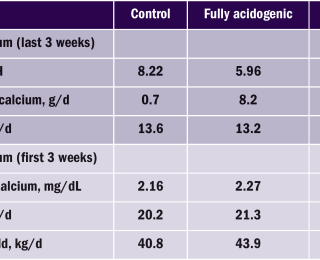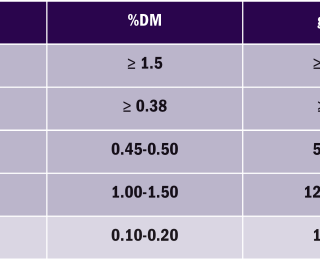Focus - Herd health - March 2020
Preventing hypocalcaemia using a negative DCAD diet
Navaratnam Partheeban MRCVS, dairy technical specialist, discusses preventing hypocalcaemia using a negative dietary cation-anion difference diet
For many years, the expectations for high milk production, animal health and reproductive performance were considered at odds with each other. As our knowledge has grown of the metabolic and physiological challenges that transition cows experience, coupled with a greater understanding of the importance of proper feeding and management for the success of these cows, we now have strategies, which help cows meet expectations for high milk yield, herd health and reproductive performance. All three are attainable and should be expected goals.
One of the most significant challenges preventing the achievement of these goals is hypocalcaemia (low blood calcium concentrations). Because the calcium (Ca)requirement of cows suddenly rises at calving, the cow may experience a transient period of hypocalcaemia. While this is normal, there are strategies available to help reduce the impacts of hypocalcaemia on cow health and productivity.
Clinical hypocalcaemia has been recognised in the field for many years, but subclinical hypocalcaemia, seen in the first few days after calving, has more recently been identified as a key issue that affects as many as 50%, or more, of fresh cows and it is strongly correlated with other fresh cow disorders (eg. metritis, retained placenta, and displaced abomasum [Venjakob et al, 2017; Rodriguez et al, 2017]).
A thorough summary of the multifaceted role that calcium plays in milk fever and its associated metabolic issues was discussed in the Veterinary Ireland Journal last year (Lawlor, 2019). This article will discuss preventing hypocalcaemia using a negative dietary cation-anion difference diet (DCAD diet). There are other options, however the negative DCAD diet is one of the main methods of prevention (Horst et al, 1997; Lean et al, 2006; Goff 2008), which has been shown to reduce the incidence of subclinical hypocalcaemia from 50-30% incidence (Joyce et al, 1997).
Feeding a negative dcad diet in the close-up period
Feeding a negative dietary cation to anion difference (DCAD) diet in the close-up period is a proven strategy to help reduce the impacts of hypocalcaemia on cow health and productivity.
Acidogenic diets and calcium metabolism
A negative DCAD diet contains a greater load of negatively charged chloride (Cl) and sulphate (S) ions compared to positively charged potassium (K) and sodium (Na) ions. Feeding a negative DCAD diet results in more of these negatively charged ions being absorbed into the blood, creating a compensated metabolic acidosis, where urine pH is significantly reduced, while blood pH is maintained in a safe range. In short, negative DCAD diets are acidogenic diets. It is important to note metabolic acidosis brought about by feeding a negative DCAD diet does not cause ruminal acidosis.
When urine pH is reduced, empirical evidence has repeatedly shown increased Ca excretion through urine, increasing calcium flux. Ca flux is the movement of Ca into and out of the blood of the cow. The Ca excreted in the urine when an acidogenic diet is fed becomes immediately available to meet the sudden increase in Ca demand when colostrum production begins at calving, helping overcome the Ca deficit in fresh cows.
Low serum Ca concentrations at calving stimulate the secretion of parathyroid hormone (PTH), which increases calcium release from the bone and vitamin D activation in the kidney (which, in turn, improves calcium absorption in the digestive tract). Feeding a negative DCAD diet tends to slightly decrease blood pH, which has been shown to improve the responsiveness of the target tissues to PTH, increasing calcium release from bone and vitamin D activation in the kidney. This is another reason why negative-DCAD diets work to support calcium status around calving.
Partial and fully acidogenic diets
An acidogenic diet should reduce urine pH below neutrality, that is, below pH7. We denote a partially acidogenic diet when urine pH falls between 6-7. Typically, such diets contain a DCAD of around 0-100 milliequivalent (mEq)/kg of dry matter (DM). This feeding strategy is effective at reducing clinical hypocalcaemia and may lower the prevalence of subclinical hypocalcaemia. Although the response to PTH is likely improved, Ca flux is not greatly increased due to the relatively small reduction in urine pH. Nonetheless, fresh cow intake and milk yield can be improved when a partially acidogenic prepartum diet is fed compared to a non-acidogenic diet.
A fully acidogenic DCAD diet maintains urine pH between 5.5-6, often using diets with a DCAD of
-100 to -150 mEq/kg of DM. These diets have been shown to significantly reduce the prevalence of hypocalcaemia by sharply increasing calcium flux due to the significant reductions in urine pH. A fully acidogenic close-up diet provides the maximum benefits in fresh cow performance, with higher intakes and greater milk production (Table 1)
The close-up diet
Low K and high magnesium (Mg) are basic critical aspects of good close-up diets. When implementing a negative DCAD strategy on farm, partially acidogenic diets have often been the norm, and they have shown to be a better approach than a standard no-DCAD diets in the nutritional management of close-up cows. Indeed, partially acidogenic diets have often been the practical choice because the impact on intake caused by customary anionic salts and products has prevented achieving fully acidogenic targets (urine pH 5.5-6) consistently.
The aim is a balanced, concentrated yet palatable supply of chloride and sulfate anions that allows not only an easy implementation of partially acidogenic diets, but also the effective implementation of fully acidogenic diets for best nutritional management of transition cows. This prepartum feeding strategy allows the cow to express her full genetic potential for milk yield, health and reproductive performance (see Table 1).
Dietary calcium requirements in the close-up
The response to fully acidogenic close-up diets may be enhanced by feeding more calcium than is customary. Recent research showed greater serum Ca ion levels in cows fed fully acidogenic close-up diets with 2% dietary Ca, compared to 1.1% or 0.5% dietary Ca (Amundson et al, 2018). Feeding higher amounts of Ca may increase passive absorption of calcium at the intestine to supply more Ca to the exchangeable calcium pool. Optimum performance of cows fed a fully acidogenic close-up diet is achieved when all nutritional requirements, including minerals are considered. One recommendation for mineral concentrations and daily intakes when a fully acidogenic, close-up diet is used are presented in Table 2.
A brief summary of other strategies to control hypocalcaemia
Feeding a low-Ca diet during close-up
While restricting calcium intake prepartum has been demonstrated to reduce clinical milk fever in a research setting, this approach is very difficult to achieve in the field. In the 1950s, Boda and Cole conducted experiments to determine the impact of dietary Ca on incidence of milk fever and serum Ca, and they showed improvements could be made on low Ca diets. Studies have demonstrated that to successfully reduce clinical milk fever by dietary calcium means alone, the intake of Ca must be low. Under most practical feeding situations, this is very difficult to attain as commonly available feeds (protein, forages and grains) all contribute to Ca in the diet.
Vitamin D therapy before calving
Research has demonstrated that this approach works, but it is not practical. To prevent milk fever, vitamin D injections must be given between day one and day four prior to date of calving using very high levels. If the cow calves outside of this window, additional injections cannot be given because of concerns for vitamin D toxicity (Gruenberg, 2020).
Reducing dietary K intake in the close-up period
While this will primarily help reduce the number of clinical cases, it will not reduce a significant amount of subclinical cases because even if potassium levels are carefully monitored, the resulting DCAD level will not be low enough to prevent subclinical hypocalcaemia.
Calcium boluses and supplementation after calving
Products marketed for subclinical hypocalcaemia prevention include oral Ca boluses that contain multiple forms of calcium salts as well as injectable Ca supplements. The use of oral Ca supplements allows for a targeted approach of high-risk cow groups within the herd (Lawlor, 2019). It was concluded by Valldecabres that calcaemic status influences the treatment response (Valldecabres et al, 2018).
Feeding Ca binders in the close-up period
Due to Ca concentrations found in common feedstuffs, it is difficult to formulate a prepartum diet sufficiently low in Ca to result in homeostatic changes as explained earlier (Horst et al, 2005). However, the effects of a low Ca dietary approach are tried to be mimicked by decreasing the bioavailability of dietary Ca with the use of a Ca binding agent. In an in vitro study, Thilsing et al (2006) showed that a synthetic sodium aluminum silicate binder, has the capacity to bind to Ca, P and Mg in rumen fluid at varying pH levels. Considerations to the use of this are cost and making sure the dry cow diet is formulated correctly.
Conclusion
In conclusion, a very effective and proven way to reduce clinical and subclinical hypocalcaemia is to feed a negative DCAD diet for at least 21 days pre-partum. Proper formulation of a negative DCAD diet is important to the success of the programme.
Navaratnam Partheeban MRCVS is a dairy technical specialist with Phibro Animal Health Corporation.
- Amundson LA, Rowson AD, Crump PM, Prichard AP, et al. 2018. Effect of induced hypocalcemia in nonlactating, nonpregnant Holstein cows fed negative DCAD with low, medium, or high concentration of calcium. J. Anim. Sci. 96: 5010-5023.
- Boda JM and Cole HH. 1954. The Influence of Dietary Calcium and Phosphorus on the Incidence of Milk Fever in Dairy Cattle. J. Dairy Sci. 37:360-372.
- Goff JP. 2008. The monitoring, prevention, and treatment of milk fever and subclinical hypocalcemia in dairy cows. Vet J.; 176:50-57.
- Gruenberg W. (n.d.). Vitamin D 3 Toxicity - Musculoskeletal System - Veterinary Manual. [online] Veterinary Manual. Available at: https://www.msdvetmanual.com/musculoskeletal-system/dystrophies-associated-with-calcium,-phosphorus,-and-vitamin-d/vitamin-d-3-toxicity [Accessed 7 Feb. 2020].
- Horst RL, Goff JP, Reinhardt TA, and Buxton DR. 1997. Strategies for preventing milk fever in dairy cattle. J. Dairy Sci. 80:1269.
- Joyce PW, Sanchez WK, Goff JP. 1997. Effect of anionic salts in prepartum diets based on alfalfa. J Dairy Sci.; 80:2866-2875.
- Lawlor J. 2019. Multifaceted role of calcium in milk fever. Ireland Veterinary Journal 9: 86-91.
- Lean IJ, DeGaris PJ, McNeil DM and Block E. 2006. Hypocalcemia in Dairy Cows: Meta-analysis and Dietary Cation Anion Difference Theory Revisited J. Dairy Sci. 89:669-684
- Leno BM, Ryan CM, Stokol T, Kirk D, et al. 2017. Effects of prepartum dietary cation-anion difference on aspects of peripartum mineral and energy metabolism and performance of multiparous Holstein cows. J. Dairy Sci. 100: 4604-4622.
- Rodriguez EM, Arís A, Bachet A. 2017. Associations between subclinical hypocalcemia and postparturient diseases in dairy cows. J. Dairy Sci. 100: 7427-7434.
- Thilsing-Hansen T, Jørgensen RJ, Østergaard S. 2002. Milk fever control principles: a review. Acta Vet Scand. 43(1):1-19.
- Valldecabres A, Pires JAA, and Silva-del-Río N. 2018. Effect of prophylactic oral calcium supplementation on postpartum mineral status and markers of energy balance of multiparous Jersey cows. J. Dairy Sci. 101:4460-4472.
- Venjakob PL, Borchardt S, Heuwieser W. 2017. Hypocalcemia — Cow-level prevalence and preventive strategies in German dairy herds. J. Dairy Sci. 100: 9258-9266.

















